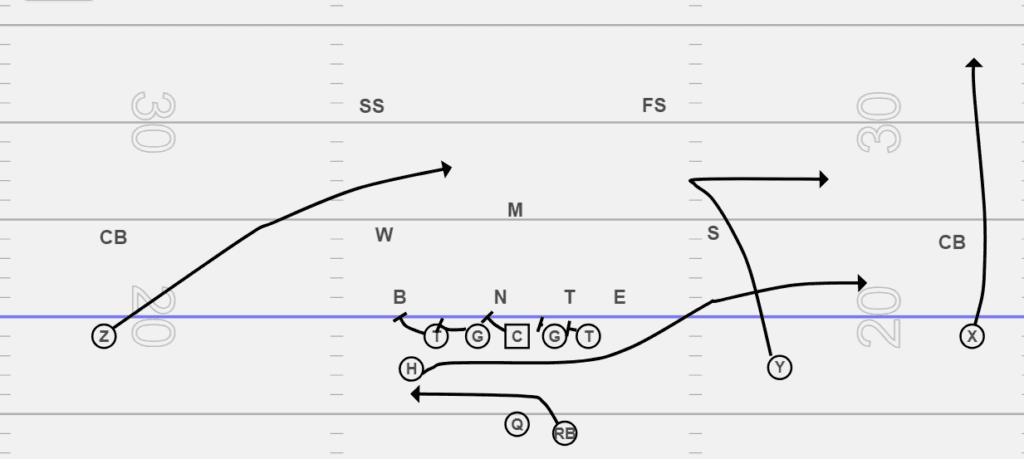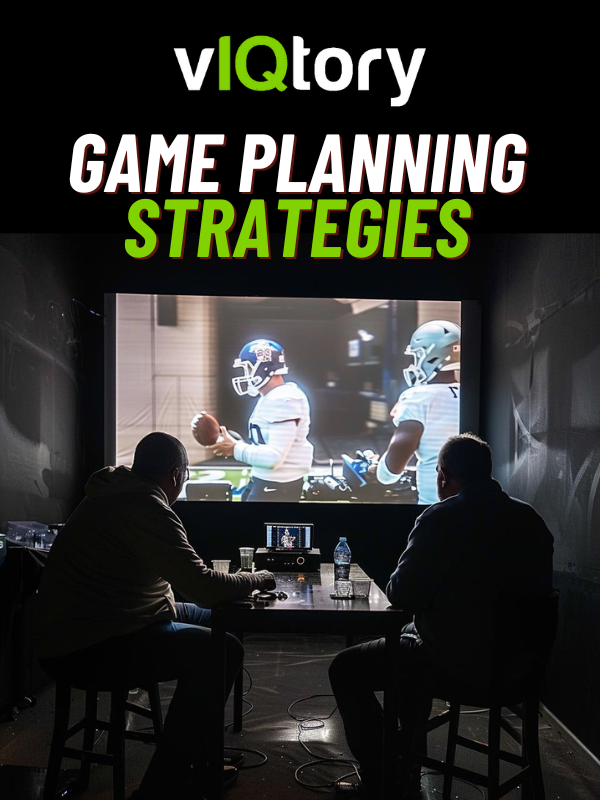As we wrote about here, the RPO game has secluded its place in the spread offense as a way to manipulate defensive schemes. However, we commonly hear announcers, and sometimes our friends mix up the difference between a play action in football and RPO. Let’s learn the difference.
The difference between the play action pass and RPO is how the offensive line blocks. During a play action pass, the offensive line will pass block. During an RPO, the offensive line will block for a run.
These types of plays for the casual fan can get confusing to the naked eye. Especially for linebackers, they would all react the same way to the backfield action.
First, let’s learn about the fundamentals of each play.
Play Action Pass
Play action passes have been a staple in offenses since throwing the football became legal. The point of the play action pass is to misguide the defense to commit to the run, then throw the ball in the open zones. The University of Oklahoma is one of the best college football to do it right now. Good play action teams will often make run plays and play action plays look identical.
It’s called play action because the offense is going to make the action of the play look like run, but it will actually be a pass. All football teams have a variation of play action in their playbook.
Here’s how each offensive position reacts to the play-action pass.
Offensive Line: The offensive line’s key to playing action is to make it look like it’s a run play. The lineman will fire out and make contact. However, they will not go downfield. They will either fire out 1 yard and make contact or kick-step backward like they normally would on a pass.
Running Back: The running back will carry his backfield action as a run. He will run full speed toward the line of scrimmage and fake the handoff. Teams usually include the running back (after the fake) in pass protection or leak him out into the route.
Wide Receiver: Receivers will immediately get into their route. The purpose of play-action is to freeze the defense, who is likely staring into the backfield, to trick them into thinking it’s run. When they realize it’s a pass, the receivers are already to the 2nd and third-level downfield.
Quarterback: Play action fakes depend solely on the quarterback. Teams often use one hand to fake the play action. The quarterbacks typically used one hand to hand off the football to the running back. The quarterback will then boot out left or right or drop straight back and throw the football.
Running Play
The most crucial part of the play action pass is the ability to fake it to the running back. A good play action fake is to make everything look like run, then at the last second, turn it into a passing play.
Play action passes can be done from under center, as well as from the shotgun formation. Teams like the Los Angelas Rams are great at running play action because it looks identical to their run game.
Good play action teams will make the play look like a running play. Once the play fake is done, and the quarterback pretends to hand the ball off, he must look for the open receiver.
Play Fake
Oftentimes, coaches will pair the play fake with crossing routes from the wide receiver.

The example above shows the team in a shotgun formation, running outside zone to the left. The line will block to the left, being conscious of not going downfield (this will result in a penalty if they go too far).
The H back (or tight end) will then slip behind the offensive linemen and get into his route. Every other receiver pretends to block then gets into their route. The backside receiver will run a crossing route as a last option for the quarterback.
The quarterback drops to his right, looking for an open receiver. If the quarterback has a good play action fake, he should have 4-5 seconds to throw the football.
If he doesn’t have a good play fake, then the defensive end or linebacker will be in his face. Every good play action pass should confuse the person watching it as the quarterback is faking it.
Learn How To Watch Film Properly…
Uncover your opponent’s offensive and defensive tendencies so you can easily build a game plan.
Inside You’ll Find:
- Strategies to pick apart defenses
- How to identify player weaknesses
- How to save time in your weekly breakdowns
RPO (Run Pass Option)
The RPO is a hybrid between the play-action and the read option.
RPOs are different because they put a linebacker or defensive back in conflict rather than the defensive end. If the linebacker commits to the run and vacates his zone/man, the quarterback will throw it.
If he hangs back and covers the pass, the quarterback will hand it off. This has made the slot corner a valuable position, forcing defenses to cover both run and pass.
The best way to determine if an RPO is being run is to focus on the lineman.
The offensive line is blocking the run, which forces the quarterback to make a fast decision about whether to hand it off or throw it. By rule, the offensive lineman can only go 3 yards downfield (if the quarterback decides to throw it) before a flag is thrown for an ineligible man downfield.
Offensive Line: Coaches are utilizing all of their running schemes. We see anything from the inside zone, outside the zone, counter, and gap schemes. The key to the RPO is the lineman are run blocking.
Running Back: Running backs will fire to the desired hole called upon for that play. This looks like a standard running play from a running back position.
Wide Receiver: Wide receivers play a big factor in the RPO game, as they’re now tagged for routes – even though a run may be called. We’ll often see them run out routes, go routes, bubbles, and speed posts.
Quarterback: Like the read-option, the decision relies on the quarterback to hand the ball off or keep it. When he keeps it, he will throw the football instead of running it as he did in the read-option.
Play Action Vs. RPO
The best way to identify the difference between the read-option, play-action, and RPO is to identify the lineman and the wide receivers.
Lineman Blocking Run + Wide Receivers Blocking Run = Read Option
Lineman Blocking Run + Wide Receivers Running Routes = RPO
Lineman Blocking Pass + Wide Receivers Running Routes = Play Action
The combination of offensive lineman blocking runs and receivers getting into their routes puts the defense (especially the linebackers) in conflict on who to cover. This is why RPOs have been red hot over the past five years and will continue to evolve.
Read Option Vs. RPO
The Read Option play is a run play that puts aggressive defense ends in conflict.
Instead of wasting an offensive tackle to block the defensive end, coaches started to “read” him. This meant not blocking him and having him make the wrong decision (the quarterback has to make the right one).
If the defensive end crashes down on the handoff, the quarterback will pull it away from the running back and keep it. If the defensive end stays on the quarterback, he will hand it off to the running back, eliminating the defensive end from chasing down the play backside.
Here’s how each offensive position reacts to the play:
Offensive Line: The read-option often features two blocking schemes: inside or outside zones. The offensive lineman will try to double team and slide off the interior lineman to a linebacker, or they will all simultaneously try to reach block a defender in the play-side gap. The main point is that they’re all run blocking.
Running Back: Running backs will fire to the desired hole called upon for that play. This looks like a standard running play from a running back position.
Wide Receiver: Wide receivers typically block or stalk block whoever is matched on them.
Quarterback: As mentioned, the quarterback can give the ball to the running back or pull it away from the running back and run himself.
Keep Learning
Like learning about football? Don’t stop here!
We’ve created the Ultimate Football Guide to help you improve your football IQ. Be the smartest in the room with this course.
If you’re looking for other resources, be sure to check these blogs out as well.
RPO In Football: What It Is & How To Run It
RPO Plays From The Spread Offense
Difference Between Play Action, RPO & Read Option
How Oklahoma Football Uses Split Backs & RPO
These three plays can often be misidentified. Announcers and commentators are often common offenders who misidentify these plays.
As football continues its innovation, read option, RPO & play-action plays will be directly linked.
Like Learning Football? Check out our Ultimate Football Guide, the complete guide to learning football!


